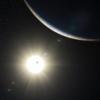

| Visitors Now: | |
| Total Visits: | |
| Total Stories: |

By Extinction Protocol: 2012 Earthchanges and News Event (Reporter)
Contributor profile | More stories
Contributor profile | More stories
| Story Views | |
| Now: | |
| Last Hour: | |
| Last 24 Hours: | |
| Total: | |
NASA mulls plan to drag asteroid into moon’s orbit
Thursday, January 3, 2013 20:21
% of readers think this story is Fact. Add your two cents.
 January 4, 2013 – SPACE - Who says NASA has lost interest in the moon? Along with rumors of a hovering lunar base, there are reports that the agency is considering a proposal to capture an asteroid and drag it into the moon’s orbit. Researchers with the Keck Institute for Space Studies in California have confirmed that NASA is mulling over their plan to build a robotic spacecraft to grab a small asteroid and place it in high lunar orbit. The mission would cost about $2.6 billion – slightly more than NASA’s Curiosity Mars rover – and could be completed by the 2020s. For now, NASA’s only official plans for human spaceflight involve sending a crewed capsule, called Orion, around the moon. The Obama administration has said it also wants to send astronauts to a near-Earth asteroid. One proposed target, chosen because of its scientific value and favorable launch windows for a rendezvous, is a space rock called 1999 AO10. The mission would take about half a year, exposing astronauts to long-term radiation beyond Earth’s protective magnetic field and taking them beyond the reach of any possible rescue. Robotically bringing an asteroid to the moon instead would be a more attractive first step, the Keck researchers conclude, because an object orbiting the moon would be in easier reach of robotic probes and maybe even humans. The Keck team envisions launching a slow-moving spacecraft, propelled by solar-heated ions, on an Atlas V rocket. The craft would then propel itself out to a target asteroid, probably a small space rock about 7 meters wide. After studying it briefly, the robot would catch the asteroid in a bag measuring about 10 meters by 15 meters and head back towards the moon. Altogether it would take about six to 10 years to deliver the asteroid to lunar orbit. The project still needs some technical and scientific fine-tuning, says co-leader Louis Friedman of the Planetary Society, but he sees it as an important boost to exploration. For instance, NASA has also expressed interest in putting astronauts on an outpost parked in orbit at the Earth-moon Lagrange point 2. From there they could study a captured asteroid using tele-presence technology, or even practice human landings on its surface. Such work could help develop ways to use asteroid material for construction or spaceship fuels, making the captured asteroid a stepping stone for human missions to larger asteroids and eventually to Mars. –New Scientist
January 4, 2013 – SPACE - Who says NASA has lost interest in the moon? Along with rumors of a hovering lunar base, there are reports that the agency is considering a proposal to capture an asteroid and drag it into the moon’s orbit. Researchers with the Keck Institute for Space Studies in California have confirmed that NASA is mulling over their plan to build a robotic spacecraft to grab a small asteroid and place it in high lunar orbit. The mission would cost about $2.6 billion – slightly more than NASA’s Curiosity Mars rover – and could be completed by the 2020s. For now, NASA’s only official plans for human spaceflight involve sending a crewed capsule, called Orion, around the moon. The Obama administration has said it also wants to send astronauts to a near-Earth asteroid. One proposed target, chosen because of its scientific value and favorable launch windows for a rendezvous, is a space rock called 1999 AO10. The mission would take about half a year, exposing astronauts to long-term radiation beyond Earth’s protective magnetic field and taking them beyond the reach of any possible rescue. Robotically bringing an asteroid to the moon instead would be a more attractive first step, the Keck researchers conclude, because an object orbiting the moon would be in easier reach of robotic probes and maybe even humans. The Keck team envisions launching a slow-moving spacecraft, propelled by solar-heated ions, on an Atlas V rocket. The craft would then propel itself out to a target asteroid, probably a small space rock about 7 meters wide. After studying it briefly, the robot would catch the asteroid in a bag measuring about 10 meters by 15 meters and head back towards the moon. Altogether it would take about six to 10 years to deliver the asteroid to lunar orbit. The project still needs some technical and scientific fine-tuning, says co-leader Louis Friedman of the Planetary Society, but he sees it as an important boost to exploration. For instance, NASA has also expressed interest in putting astronauts on an outpost parked in orbit at the Earth-moon Lagrange point 2. From there they could study a captured asteroid using tele-presence technology, or even practice human landings on its surface. Such work could help develop ways to use asteroid material for construction or spaceship fuels, making the captured asteroid a stepping stone for human missions to larger asteroids and eventually to Mars. –New Scientist
2013-01-03 20:17:07
Source:


